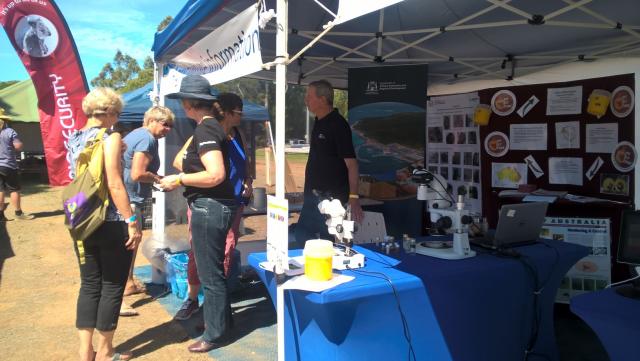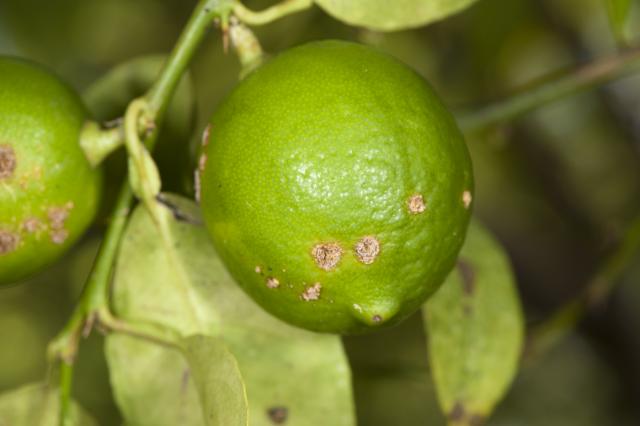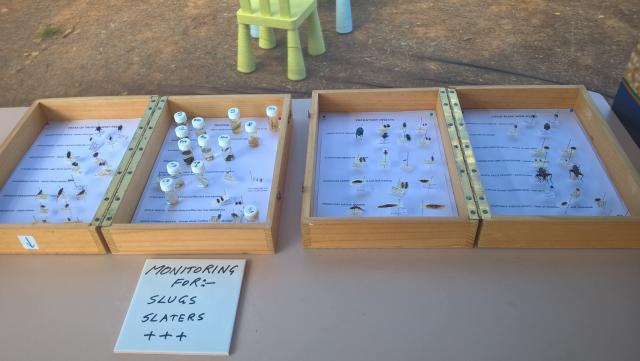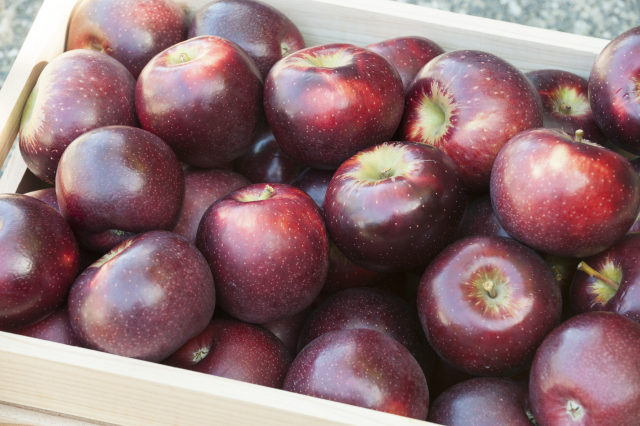- Visit DPIRD at Truffle Kerfuffle
- Time to check trees for citrus gall wasp
- Seeking out potential irrigation development in the Pilbara
- 2019 Bravo® apple harvest underway
- Citrus canker quarantine extended to 2020
Visit DPIRD at Truffle Kerfuffle
Find out whether pests think truffles are as much of a delicacy as we do at the Department of Primary Industries and Regional Development’s (DPIRD) display at the annual Truffle Kerfuffle in Manjimup from 21-23 June.
DPIRD will again sponsor and be part of Western Australia’s Truffle education and information tent.
Participants can check out the displays of pests of truffles and their host trees, and monitoring traps at the DPIRD display.
They can also speak with pest experts, Stewart Learmonth and Alison Mathews, on their recent research into pests and diseases and discuss the various aspects of truffle production, market options and the future directions for the industry.

Truffles, or more specifically black truffles produced by Tuber melanosporum, are a growing industry in WA, with much of the production currently occurring around the Manjimup region.
Black truffles are a culinary delicacy in world demand and the Manjimup region in WA’s south west is well recognised for their quality production of this delicacy.
DPIRD has been working with the industry for several years on a range of projects, to assist the industry grow and prosper. These include:
- Pests and diseases of truffles and their host trees in Australia – a DPIRD-led national project to identify pests affecting truffles and their host plants and developing management strategies
- Value adding to truffle in Western Australia – a DPIRD grower group R&D fund grant to identify value added options for the industry to build market diversification
- WA truffle industry strategic plan development – a DPIRD supported project to assist the industry identify and prioritise the steps required to see continued growth and prosperity.
For more information, contact Alec McCarthy, or visit DPIRD’s website for articles on the truffle industry in WA, truffle production and pest management.
Time to check trees for citrus gall wasp
Now is the time to monitor citrus trees for the destructive pest, citrus gall wasp, which attacks all types of citrus trees, reducing the amount of fruit produced and in severe cases, can cause tree dieback.
The Department of Primary Industries and Regional Development (DPIRD) and industry group WA Citrus are appealing to citrus tree owners in regional Western Australia to check their trees and implement control measures to reduce the threat to the WA citrus industry.
The wasp is an Australian native insect from northern New South Wales and Queensland, which has established in Perth suburbs after it was first detected in 2013. It forms distinctive galls on stems which look like woody bulges up to 250 mm long and 25 mm thick.
New-season galls started to become visible in April and are easy to see by June. Pruning out branches affected by galls is essential for controlling citrus gall wasp, and June is the ideal time to do this.
Any pruning of branches after 30 June will also need solarising treatment, where the material is placed in a sealed plastic bag and left in the sun, to stop wasps emerging from the galls.
Regional citrus tree owners are encouraged to check their trees and use the department’s MyPestGuideTM Reporter app to report its presence or absence. These reports help us to keep track of the wasps spread.
The wasp could move into regional areas on infested trees from the Perth Metropolitan area. It is important to keep a close eye on any recently purchased or relocated trees and act quickly if galls appear.
Further information on citrus gall wasp control is available on the department's website.
Anyone finding citrus gall wasp can report it using the department’s MyPestGuideTM Reporter app or send an email to the Pest and Disease Information Service or phone (08) 9368 3080.
Seeking out potential irrigation development in the Pilbara
The Transforming Agriculture in the Pilbara (TAP) project is currently undertaking land and water assessments, which will validate water resources and soils at a number of sites including Lower DeGrey River, Shaw River, north Newman and Karratha Hinterland.
Department of Primary Industries and Regional Development (DPIRD) soil scientist Henry Smolinski and senior technical officer Tim Pope recently completed surveying in the Shaw River area, North West of Marble Bar. They were on the lookout for free draining soils with good nutrient and water holding capacity that are highly suitable for irrigation.
Mr Smolinski said his team observed considerable areas of red loamy soils that have a sandy loam to clay loam soil texture.
“These loamy soils, particularly the coarser textured sandy loams, are better drained and can be irrigated with less potable water,” Mr Smolinski said.
“Matching soils with water supplies of varying quality is one of the challenges in determining site suitability for irrigation development.”
Further north in the Karratha Hinterland, Mr Smolinski surveyed the Horse Flat land system locally known as the Roebourne Plains.
He found red cracking clays being extensive on the alluvial plains between Karratha and Port Hedland and have a high water holding capacity but commonly have salt within the subsoil. However, when this soil type occurred near the main river systems and subject to more frequent flooding, they have been leached of salt and highly suitable for irrigation.
DPIRD hydrogeologist Bob Paul is collecting water samples from bores belonging to pastoral and mining companies in the area to determine the depth to groundwater and water quality.
Groundwater resources for irrigation are required to have low levels of total dissolved salts and must be found at relatively shallow depths below ground level in order to minimise pumping costs.
Project manager Chris Schelfhout said the soil and water information collected by the TAP project would allow developers to focus on locations that had good quality water and soils that were most suitable for irrigation.
This information will be shared with other agencies including the Department of Water and Environmental Regulation to enable more efficient decision making when processing water licence and development applications.
DPIRD has been working with pastoralists and aboriginal corporations in the TAP focus areas but is keen to engage with others in the Pilbara seeking to understand more about irrigation opportunities on their tenure.
Anyone interested are encouraged to get in touch with Chris Schelfhout or phone 9143 7011.
2019 Bravo® apple harvest underway
The start of the 2019 Bravo® apple season was recently launched with the dark burgundy apples now available from retail outlets.
Agriculture and Food Minister Alannah MacTiernan launched the fourth harvest of the variety, which was developed in Western Australia over two decades by the Department of Primary Industries and Regional Development.
A total of 26 WA apple orchards from the Perth Hills, Manjimup and Donnybrook are expected to supply about 1000 tonnes of Bravo® apples to the local, interstate and export markets over the next few months. The variety has been widely adopted in the south-eastern states.
Efforts are being made by the licensed marketers of the variety to cultivate export markets, particularly in nearby South East Asia and the Middle East, where premium quality fruit is highly prized when celebrating festive events.
The department continues to work towards the development of new varieties suitable for growing in WA conditions, through the national apple breeding program.
Fruit lovers are encouraged to share their enjoyment of consuming Bravo® apples and help promote the new variety via social media, using the hashtag #ilovebravoapples.
Citrus canker quarantine extended to 2020

The Quarantine Area Notice for areas around Kununurra and Wyndham has been extended to 31 October 2020, meaning the restrictions on the movement of citrus plants and fruit will continue until this time.
There are no changes to the conditions of movement which were originally introduced in June last year after the destructive disease citrus canker was detected on three properties in the State’s north west.
Under the notice, areas covering a 50-kilometre radius around Kununurra and Wyndham are subject to controls on the movement of citrus fruit and plants, as well as equipment and machinery.
The Quarantine Areas will continue to be separated into Restricted Areas and Control Areas, with tighter movement conditions for the Restricted Areas. To find out if you are in a Control Area or Restricted Area, you can search in the interactive map online.
Department of Primary Industries and Regional Development staff carried out extensive surveillance across northern WA in 2018 and found no additional detections of the disease. As a result, the department announced in March this year that replanting of citrus in Restricted Areas could recommence.
Residents living in a Restricted Area who want to replant need to complete an authorisation form and submit it to the department for approval before purchasing citrus plants. Residents are required to keep the approved form and the purchase receipt for the plants until the area is no longer a Quarantine Area for citrus canker.
Obtaining a permit is a straightforward process and allows the department to trace plants and continue surveillance for citrus canker to ensure the disease is not present.
As part of the permit conditions, residents who replant will need to inspect their plants once a month and report any unusual signs to the department using the MyPestGuide app, or by contacting the Pest and Disease Information Service on (08) 9368 3080 or at padis@dpird.wa.gov.au
Department inspectors will continue to undertake surveillance work to gather data to prove the area is free from citrus canker. More information on the conditions for replanting and the citrus canker authorisation to replant form can be found on the department’s website.



